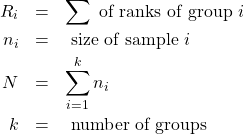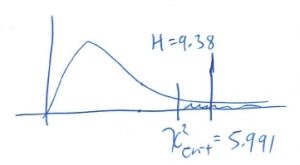16. Non-parametric Tests
16.6 Kruskal-Wallis Test (H Test)
The Kruskal-Wallis Test is a non-parametric one-way ANOVA. It detects differences in means between groups. The distribution behind the test is a new discrete distribution called the ![]() distribution that assumes the group samples come from populations with identically shaped distributions. We will use a
distribution that assumes the group samples come from populations with identically shaped distributions. We will use a ![]() approximation of
approximation of ![]() for computing the critical statistic so, for that approximation, we need
for computing the critical statistic so, for that approximation, we need ![]() for
for ![]() , where
, where ![]() is the number of groups. The hypothesis tested is :
is the number of groups. The hypothesis tested is :
![]() : means of groups all equal
: means of groups all equal
![]() : means of groups not all equal
: means of groups not all equal
As mentioned, the critical statistic is ![]() with
with ![]() degrees of freedom which we can find using the Chi Squared Distribution Table.
degrees of freedom which we can find using the Chi Squared Distribution Table.
The test statistic is :
![Rendered by QuickLaTeX.com \[ H = \frac{12}{N(N+1)} \left[ \sum_{i=1}^{k} \frac{R_{i}^{2}}{n_{i}} \right] - 3(N+1) \]](https://openpress.usask.ca/app/uploads/quicklatex/quicklatex.com-82e798922cd2df85aadc57122d60c03d_l3.png)
where

The test is always right-tailed.
Example 16.8 : With the following data on ml of potassium/quart in brands of drink, determine if there is a significant difference in the potassium content between brands.
| Brand A | Brand B | Brand C |
| 4.7 | 5.3 | 6.3 |
| 3.2 | 6.4 | 8.2 |
| 5.1 | 7.3 | 6.2 |
| 5.2 | 6.8 | 7.1 |
| 5.0 | 7.2 | 6.6 |
0. Data reduction.
We need to rank the data. Ranking “in place” we have :
| Brand (IV) | DV | Rank |
| A | 4.7 | 2 |
| A | 3.2 | 1 |
| A | 5.1 | 4 |
| A | 5.2 | 5 |
| A | 5.0 | 3 |
| B | 5.3 | 6 |
| B | 6.4 | 9 |
| B | 7.3 | 14 |
| B | 6.8 | 11 |
| B | 7.2 | 13 |
| C | 6.3 | 8 |
| C | 8.2 | 15 |
| C | 6.2 | 7 |
| C | 7.1 | 12 |
| C | 6.6 | 10 |
Using A = 1, B = 2, c = 3, the sums of the ranks for each group are

Finally note that ![]() and
and ![]() .
.
1. Hypothesis.
![]() : no differences in means between the brands
: no differences in means between the brands
![]() : some differences exist
: some differences exist
2. Critical statistic.
From the Chi Squared Distribution Table with ![]() ,
, ![]() find
find
![]()
3. Test statistic.
![Rendered by QuickLaTeX.com \begin{eqnarray*} H & = & \frac{12}{N(N+1)} \left[ \sum_{i=1}^{k} \frac{R_{i}^{2}}{n_{i}} \right] - 3(N+1) \\ & = & \frac{12}{15(16)} \left[ \frac{15^{2}}{5} + \frac{53^{2}}{5} + \frac{52^{2}}{5} \right] - 3(16) \\ & = & 9.38 \end{eqnarray*}](https://openpress.usask.ca/app/uploads/quicklatex/quicklatex.com-620477edfde356e95fc69c5bcbadebbb_l3.png)
4. Decision.

Reject ![]() .
.
5. Interpretation.
At least one of the brands is different. Since ![]() is far less than the rank sums of the other two brands, we know that Brand A is different before we do any kind of post hoc testing.
is far less than the rank sums of the other two brands, we know that Brand A is different before we do any kind of post hoc testing.
▢

